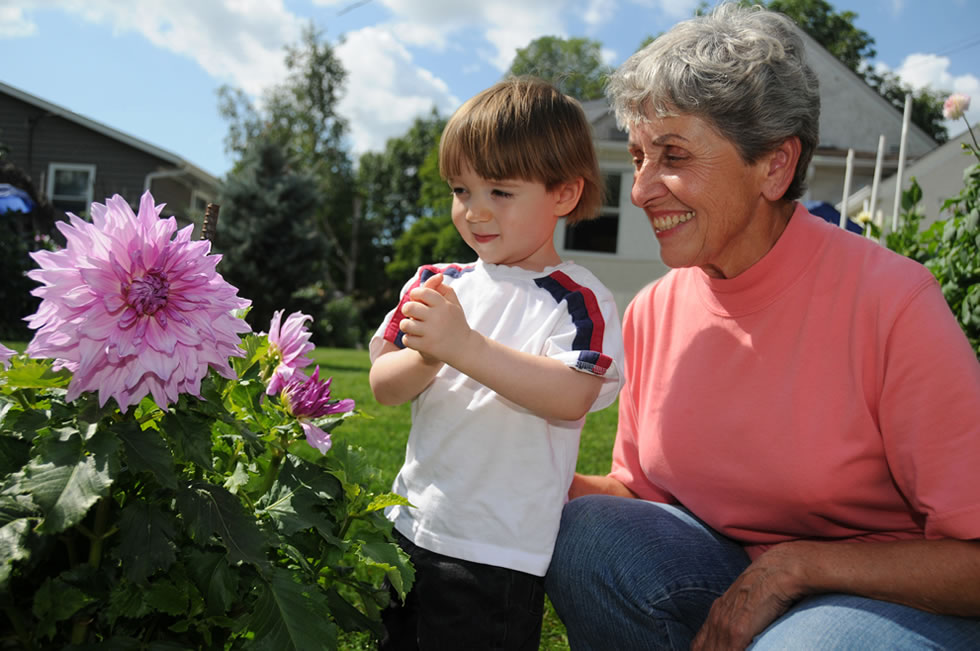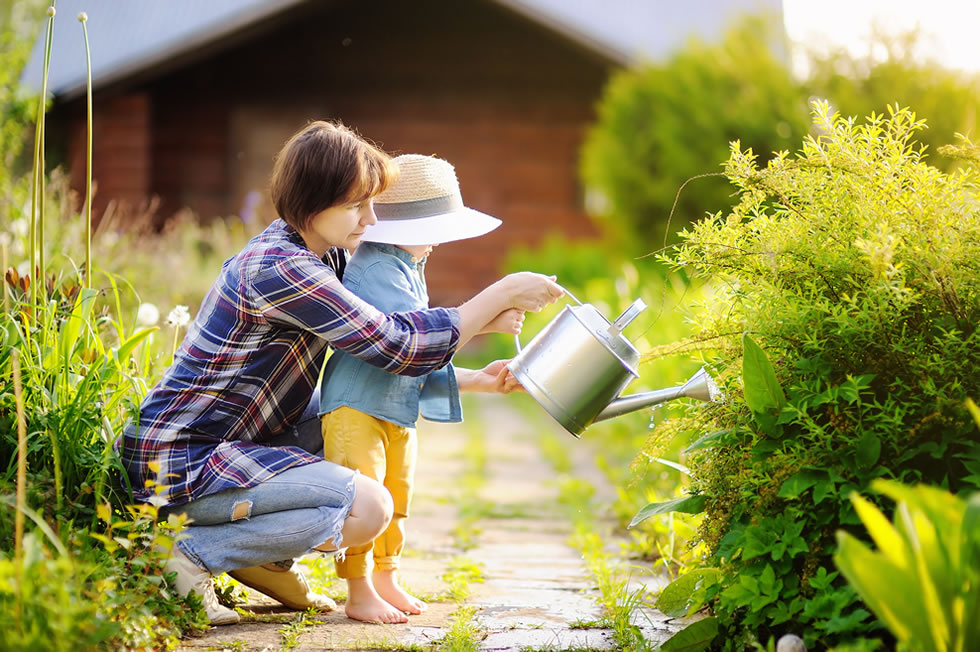
Not everybody wants or has a large garden. Some view it as an expense to plant and maintain on their own or with professional help. But they know its numerous advantages. Almost any green space can help increase the value of a home according to a report from the National Association of Home Builders. In fact, 75 percent of millennials want an outdoor space reports NAHB.
Seeing greenery, even from the indoors looking out, also benefits home owners’ healthfulness. It improves a person’s physical and psychological well-being, and why some professionals and home owners take cues from healing experts and plant gardens to spark wellness. Certain kinds of plantings encourage mediation because of their soft colors or textures; some have fragrances that help boost memories (those lilacs from a grandmother’s garden); or improve physical skills by spurring a walk down a gravel path.
But planting a small garden—whether a patio edged with containers or lawn accented by flower beds—requires decision making so it looks its best and survives. We talked with master gardener Carole Aine Langrall, owner of The Flower Spy, in Baltimore and Santa Fe, whose different climates and terrains have inspired very different looking gardens. Here’s her 11-step guide that she suggests others follow to produce a successful small garden or tweak an existing one.

- Develop your vision. Decide the prime purpose of your garden. Is it to cook, bird watch, attract bees and butterflies or enjoy a game of bocce? Maybe, you have multiple goals, but decide how many based on the size of your garden. Leave some room between activities to have a comfortable spot to savor the view. "Make sure to have a nice seating area and even a swinging chair or hammock," Langrall says.
- Decide on your budget. Set aside 10 to 15 percent of the value of your house for your outdoor design and furnishings. "If the garden is larger, set aside more funds," she says. And she recommends that home owners first go online and see gardens they like and jot down ideas or print out pictures since different features cost various amounts.
- Factor in your soil and hours of sun versus shade. Get a soil test done so you know if it has any lead or other chemicals which will preclude a vegetable or herb garden in the ground. You might then go with containers, she says. Don’t stop there. Also find out how many hours of sun and shade the garden will receive. "It’s always easier to add shade by planting trees or shrubs," she says. Also, check the slope and learn what native species grow in the area since those will thrive more. There are many online resources to help you determine the amount of sun and shade your yard receives. Such information is key when you go to a nursery to buy plantings or hire a professional to help. You can also reach out to your area college extension service. Find professionals through the National Association of Landscape Professionals, based in Fairfax, Va., and landscape designers through the Association of Landscape Professionals in Harrisburg, Pa. A local nursery often knows best what to grow—and not—and how to keep wildlife away.
- Consider all your senses when planning: Vegetables, herbs or fruit offer taste. Different types of plants provide texture and touch including bark of trees. Birds, chimes and recirculating water offer pleasant sounds. However, know that too many chimes may annoy your neighbors, says Langrall. Certain flowers produce aromas—but be careful about those that will disagree with homeowner allergies, as specific grasses, plants and trees produce pollen. Pleasant sights can mean different shaped and colored flowers that do double duty by bringing pollinators into the yard. Many homeowners like to add a fire component, maybe, a fire pit or larger, freestanding fireplace.
- Make gardens a four-season delight. Think beyond spring when the first flowers open, summer when a garden is typically at its peak and fall when a riot of colors arrives in many areas. Winter, too, should become enjoyable with the sight of different branch structures, different types of evergreens, different berries. Langrall leaves grasses and certain plants in pots and the ground in her Baltimore garden rather than removing them, unless they get very straggly, she says. This fits in with the new trend of the "perennial movement," she says, which involves choosing stylized designs more for plant structure than color for four-season delight. "The cycle of life means we shouldn’t get discouraged when all is not at its best. We just need to adjust our perspective," she says.
- Balance hard and softscape choices even with less space. Expensive hardscape choices can often be included since there’s less square footage to pay for if you love pricey bluestone, for example. When dollars must be watched, consider gravel, much less costly. Softscape includes everything from lawn to flowers, vegetables, fruits and herbs. Langrall likes to give half of the space to the hardscape and half to the softscape, sometimes with the lawn in the center and rocks bordering it.
- Make water available. Always incorporate some source of water whether a built-in sprinkler on a timer—the costliest option—or less expensive hoses of some kind. But add water for visual and sensory pleasure in other ways, through bird baths, fountains and small ponds.
- Think horizontal and vertical directions. You can go vertical with ladders that lean against the house or stand upright on their own and become living "walls" or plant directly on a wall with vines such as clematis. "It’s a great way to cover up any ugly area," she says.
- Create a palette. It doesn’t matter whether you go monochromatic—an all-white garden that is striking at night, one in complementary hues or the current rage of bright, bold colors, inspired perhaps by Pantone’s Color of the Year–coral. Langrall considers herself a purist who year after year favors a garden with white, black, sage and silver colors.
- Shower all with TLC. When planning, think about the amount of time you want to spend weeding, pruning, repotting and so on, or having someone else take care of such chores. Gardens represent part of a home’s curb appeal and an untended garden can quickly become an eyesore and a turnoff for resale. "Gardens are really like pets and require feeding, watering and tending," Langrall says. "Containers with native perennials do tend to take care of themselves," she says, "but not completely. Annuals represent higher maintenance," she says.
- Change it up periodically. Even the best gardens may get tired looking, and you may tire of looking at the same scape. Consider changing it up. Head to your garden center, look online, walk through your neighborhood, find new fresh ideas and hire a consultant. "It won’t cost you a lot and give you ideas of what to investigate," Langrall says.
SIDEBAR: Small gardens help to transform multifamily terraces. In the past, terraces and balconies of multifamily buildings, both in big and small cities and even the suburbs, often were neglected and became just a place to set a chair or two and barbecue if permitted. But more home owners now view them as important extra square footage and are transforming them like they do their interiors. They are seeing on HGTV shows, in shelter magazines and in their neighbors’ outdoor spaces the rewards: an extra place to eat, unwind, cook and savor great vistas. Add a rug, more furnishings, binoculars or a telescope, and voila, it’s another living space but with fresh air and breezes. In New York City, Frans Preidal, an associate real estate broker at The Corcoran Group, established his firm’s The Terrace Experts team 15 months ago after witnessing a rising interest in listings with outdoor space. The dollar value an outdoor space adds depends on such criteria as its location in relationship to the indoor living area—if easily accessible, and its livability, which includes its size and ability to arrange furnishings and view. A small 3-by-4-foot terrace is nice but much less usable than one 13-by-7-feet, says Kelly Fritz, a colleague of Preidal’s at Corcoran and real estate salesperson. Her company has found that a terrace is the only “accessory” to make a buyer relocate to a different neighborhood, she says.
